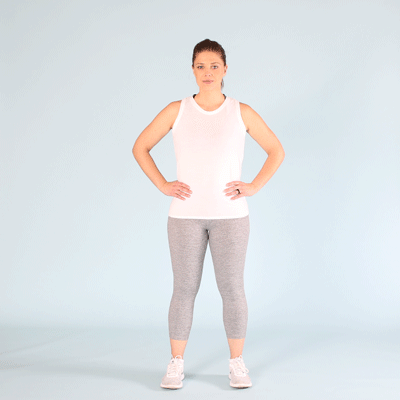The number of squats you should aim to do in a day depends on your overall health and fitness goals. If you’re just getting started, you may want to focus on your form instead of doing a specific number.
Good things come to those who squat.
Not only will squats shape your quads, hamstrings, and glutes, they’ll also help your balance and mobility, and increase your strength. In fact, a 2002 study found that the deeper your squat, the more your glutes will work. Convinced yet?
When it comes to how many squats you should do in a day, there’s no magic number — it really depends on your individual goals. If you’re new to doing squats, aim for 3 sets of 12-15 reps of at least one type of squat. Practicing a few days a week is a great place to start.
Below, we’ve mapped out the basic squat and three variations of it so you can get to work.
You’d be hard-pressed to find a more fundamental exercise than the basic squat. When performed properly, it engages the largest muscles in the body to provide many functional and aesthetic benefits. In case you were wondering, squats will definitely help lift and round out your butt.
To get moving:
- Start by standing with your feet shoulder-width apart, resting your arms down at your sides.
- While bracing your core and keeping your chest up and neck neutral, bend your knees and push your hips back as if you’re going to sit in a chair. Your arms should raise up in front of you to be parallel to the floor.
- When your thighs are parallel to the floor, pause. Then push up through your heels back to your starting position.
A favorite to really target the glutes, curtsy squats will have you feeling fancy AF.
When you can knock 10 of these out on each side without breaking a sweat, up your game by holding a dumbbell in each hand.
To get moving:
- Start by standing with your feet shoulder-width apart. Hold your arms in a comfortable position. You can rest your hands on your hips or keep them down at your sides.
- With a strong core, step back and across with your right foot until your left thigh is parallel to the floor. Ensure that your chest and chin stay upright throughout this movement.
- After a brief pause, push up through the heel of your planted left foot and return to your starting position.
- Repeat, but step back with your left foot instead. When you finish this side, you’ve completed one rep.
Similar to a lunge, the split squat requires a split stance, isolating one leg at a time. This will require more balance, so really focus on that as you’re in motion.
To get moving:
- Start in a wide-staggered stance, with your right leg in front and your left leg behind.
- Keep your arms down at your sides. If you need an added challenge, hold a light dumbbell in each hand.
- While keeping your chest up and core braced, bend your knees until your left knee nearly touches the floor and your right thigh is parallel to the floor. Ensure that your right knee doesn’t extend past your toes.
- After a short pause, return to your starting position. Repeat your desired number of right-leg reps, then switch your stagger to complete your left-leg reps.
Strength and conditioning coach Dan John created this move to help people who have trouble mastering squats or experience pain during the basic squat movement.
Equipment: A dumbbell. Start light with 10 pounds if you’re a beginner.
To get moving:
- Begin by grabbing your dumbbell by one end, allowing the other end to hang toward the floor, with your hands cupped.
- With bent elbows, hold the dumbbell comfortably in front of you, touching your chest. Your stance should be wide and your toes should be pointed out.
- Bend your knees and start to push your hips back, keeping the dumbbell stationary. Keep your neck neutral and gaze straight ahead. If your range of motion allows for it, your thighs can go deeper than parallel to the floor.
- After a slight pause, push through your heels and return to your starting position.
After you master these squat variations, up your game with this 30-day squat challenge. Remember, 1 set should equal about 12-15 reps when you start out. You’ll be doing 3 sets of the specified squat — so grab your water and get ready.
For a higher intensity workout, you can add a few reps or grab some dumbbells when you hit week 3, or day 15.
Make sure you’ve warmed up before you start squatting. Doing at least 10 minutes of cardio and 5 minutes of stretching will loosen up your muscles, increase your range of motion, and help prevent injury.
The number of squats you should do has nothing to do with your gender and everything to do with your fitness level. Be mindful of your limits and make sure your form is solid before adding additional reps or weight.
Although squats are an amazingly effective exercise, they aren’t the end-all-be-all. Incorporating them into a full-body workout regime — and eating the good stuff in appropriate portions — will give you the best results.
As a beginner, squatting 3 sets of 12-15 reps several times a week will have you well on your way to more strength and fuller jeans. Incorporate them into a well-rounded exercise routine and watch the results flow!
Nicole Davis is a Boston-based writer, ACE-certified personal trainer, and health enthusiast who works to help women live stronger, healthier, happier lives. Her philosophy is to embrace your curves and create your fit — whatever that may be! She was featured in Oxygen magazine’s “Future of Fitness” in the June 2016 issue. Follow her on Instagram.


